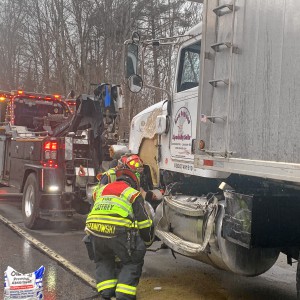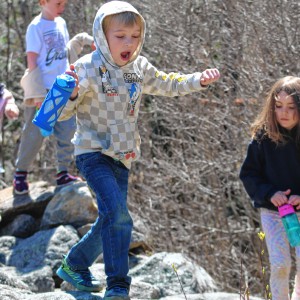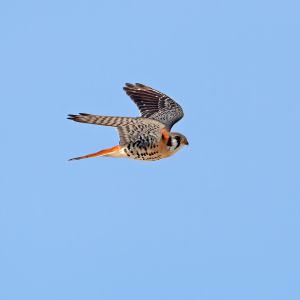Black bears mostly in their dens for the winter
| Published: 11-29-2022 12:32 PM |
Andrew Timmins, bear biologist at New Hampshire Fish and Game, said there are currently around 6,800 black bears living in the state.
Bears exist in every part of New Hampshire except for the immediate Seacoast. The Lakes Region and White Mountains have the highest density, and on average the state has half to three-quarters of a bear per square mile.
Back in the 1980s, there was a movement to conserve the bear population. People thought bears could only survive in remote places and were concerned for their future.
“They’ve proven us wrong,” Timmins said, “Bears are highly adaptable to human environments.”
In fact, “bears have learned to capitalize on human-related foods,” he explained. Given the chance, they will eat out of trash cans, knock down bird feeders and even steal a chicken out of a coop. These food sources can be much more calorie-dense than what a bear would be able to find in the wild; bears are omnivores and 80 percent of their natural diet is vegetation. The other 20 percent is mainly colonial insects, or a bear may occasionally feed on a carcass.
“This year has been particularly challenging,” Timmins said. It was a dry summer, which resulted in fewer berries and plants for bears to eat. The lack of natural food caused some bears to den as early as late September.
It also caused more bears to seek food in residential areas.
“People have seen more bears [this year] than in the past,” Timmins said.
Article continues after...
Yesterday's Most Read Articles
 UPDATE: Drivers identified in Jaffrey dump truck crash
UPDATE: Drivers identified in Jaffrey dump truck crash
 Conant baseball shows its strength in win over Mascenic
Conant baseball shows its strength in win over Mascenic
 Group looks to close divide in Mascenic district
Group looks to close divide in Mascenic district
 Bernie Watson of Bernie & Louise dies at 80
Bernie Watson of Bernie & Louise dies at 80
 Rindge Recreation Department organizes a trip to Converse Meadow
Rindge Recreation Department organizes a trip to Converse Meadow
 Scott Bakula starring in Peterborough Players’ ‘Man of La Mancha’
Scott Bakula starring in Peterborough Players’ ‘Man of La Mancha’
Bears have been seen in people’s yards and in neighborhoods. This has been an increasing trend in recent years. As the region experiences more dry summers that produce less food, bears are forced to look for sustenance elsewhere, and it turns out they are good at finding it.
“We know bears move with food, congregate around food-related areas,” Timmins said. “The primary reason bears den is to deal with periods of food shortage.”
At this point in the year, most black bears have already gone into their dens for the season.
“A bear is not a true hibernator,” Timmins said.
While their body temperature, respiration and heart rate all drop while they are denning, they “don’t go into a state where they can’t be aroused.” They are able to move if they are disturbed and can find a new den if theirs is compromised. But the long period of denning still allows bears to survive the winter without eating, and hopefully they had put on enough fat in the fall to last them until spring.
When bears den depends greatly on food, as well. At some point, it becomes more energy-efficient for bears to den than to continue to move around and use energy looking for food.
“On poor food years we see bears den earlier,” Timmins said. “On a really good food year, it’s not uncommon for bears to stay active through November, even December.”
Bears will stay in their den until mid-March or the beginning of April and will burn 25 percent or more of their body fat. Female bears who breed in the summer will give birth to their cubs inside the den in January. Cubs will then be sent out on their own at 18 months. The mother may let a female bear occupy part of her own range, but the male bears are kicked further from home.
Bears tend to den in a core part of their home range. Common dens are dug under uprooted tree roots, log piles and brush piles.
“Once it gets blanketed in snow it’s hard to notice,” Timmins said.
Occasionally a dog will sniff a bear out, but the most-common den disturbance comes from logging. However, Timmins said loggers are usually happy to give the bear its space.
Unlike this year, the trend is that “bears are denning later and for shorter periods of time,” Timmins said. As well as causing droughts, climate change is causing warmer, shorter winters and falls without snow. Bears are able to move around later without using as much energy.
And access to human foods may have an impact on bear reproduction. In addition to bears being more comfortable in residential places and around humans, “certainly access to that human food can result in bears getting very large,” Timmins said, which may be causing abnormal litter sizes. Historically, bears have had one cub their first litter then may have two to three in consecutive litters. Now, there have been reports of bears birthing four or five.
Timmins said in parts of the country where bears have been able to consume lots of sugar, they have experienced tooth decay.
“It’s important to recognize that bears are wild animals. They’re very unpredictable,” he said, “People don’t need to fear them. They’re not dangerous animals. [People] just need to respect their space.”
New Hampshire Fish and Game advises only keeping bird feeders out from Dec. 1 to April 1. In the southern part of the state, including the Monadnock region, Fish and Game will often send out a press release informing people to take their bird feeders inside by March 15. People are also advised to keep trash cans and pet food inside a structure bears cannot access. Dumpsters should have a metal top with a latch. When camping, it is important not to leave food exposed and not to put food in the tent where campers are sleeping. Timmins recommends people with poultry have electric fences to keep bears out.
“Bears are very easy to coexist with if you’re willing to take responsibility,” he said, “If you choose not to do that stuff, you will have problems with bears.”
Timmins emphasized that most bear encounters are not aggressive, but “dogs have the ability to escalate what would be a very benign confrontation with a bear.” He suggests that dog-owners be aware of this and suggests keeping reactive dogs on a leash and under control in the forest.

 The Greenfield Beat: Jesseca Timmons – Diana Dunbar Place focuses on life’s ‘third act’
The Greenfield Beat: Jesseca Timmons – Diana Dunbar Place focuses on life’s ‘third act’ T & W Handyman Services in Jaffrey celebrates new location
T & W Handyman Services in Jaffrey celebrates new location BACKYARD NATURALIST: Phil Brown – Kestrel conservation expands in the Contoocook Valley
BACKYARD NATURALIST: Phil Brown – Kestrel conservation expands in the Contoocook Valley
